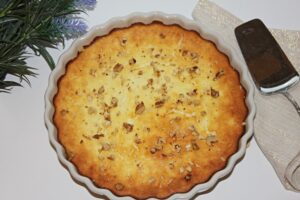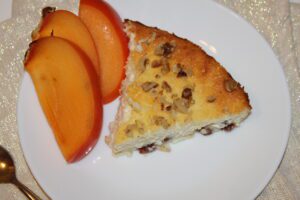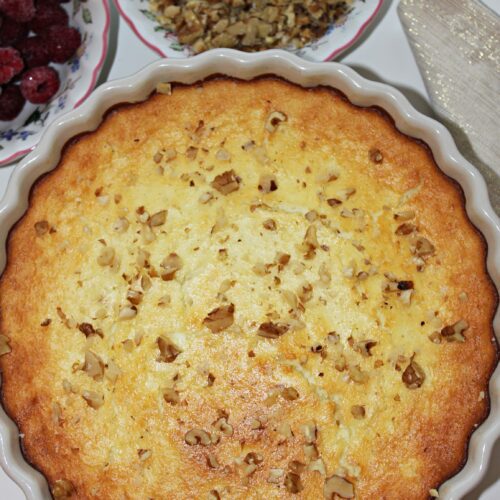In the busy rush of mornings, it’s tough to find a breakfast that’s both healthy and yummy for kids. But don’t worry! Today, we have something exciting to share. We’ve come up with a super tasty twist for a kid-friendly breakfast! We’re introducing our “Kid-Approved Morning Magic: Cottage Cheese Cheesecake Recipe.” This fun breakfast makes your little ones smile. Say bye to boring breakfasts and let’s enjoy a delightful and delicious morning together! 🌈🍰

Ingredients for Cottage Cheese Cheesecake
Imagine this: a breakfast that’s not just good for you but feels like a special treat. That’s what our Cottage Cheese Cheesecake is for our family – a delightful creation that quickly became a beloved favorite. It’s a unique twist that adds joy to our breakfast routine. 🌅🍰
- 1,3 lb (600 g) cottage cheese
- 2 free-range eggs
- 3 Tbsp organic wheat semolina*
- 3 Tbsp almond flour*
- 2-3 Tbsp agave nectar (or any sweetener)
- Vanilla extract
- 1/3 cup organic raisins/dried cranberries
* For gluten-free version, instead of semolina and almond flour you can use 1/3 cup corn starch (NOT a corn flour!). Read the difference here.
Cooking Instructions
Prepare Cottage Cheese Base. Use an immersion blender to achieve a creamy consistency in the cottage cheese. Be cautious not to over-blend; we’re aiming for creaminess, not cream cheese thickness.
In a separate bowl, use a mixer to beat the eggs until stiff peaks form.
Mix the beaten eggs with the cottage cheese. Add semolina and almond flour (or corn starch), agave nectar, and dried berries.
Preheat the oven to 356° F (180°C). Grease the baking form with butter.
Pour the well-blended cottage cheese mixture into the prepared baking form.
Bake the cheesecake for approximately 45-55 minutes, ensuring a golden brown finish. Cool completely before serving.
Enjoy!
A Taste of Home: Cottage Cheese Casserole with a Pear and Orange
Beating Eggs Until Stiff Peaks Form is a Crucial Step
- Texture and Volume: Beating eggs to stiff peaks incorporates air into the mixture. This trapped air expands during baking, contributing to a lighter and fluffier texture in the final product. In the context of a cheesecake, this step helps achieve a creamy and airy consistency.
- Structural Support: Stiff egg whites provide structural support to the overall mixture. When baked, the proteins in the egg whites coagulate and help the cheesecake set properly. This is especially important in recipes without traditional flour-based crusts, where eggs play a more significant role in structure.
- Leavening Agent: In some recipes, beaten egg whites act as a leavening agent, helping the batter rise. This is particularly relevant in desserts like soufflés and certain types of cakes, but the principle applies to cheesecakes as well.
- Preventing Collapse: Stiff egg whites help the cheesecake maintain its volume during baking and prevent it from collapsing as it cools. This is crucial for achieving the desired texture and presentation.
In summary, beating eggs until stiff peaks form serves both structural and textural purposes, contributing to the overall success and quality of the cheesecake.

Serving Tips and Suggestions
No more dull mornings with the same old breakfasts – our Cottage Cheese Cheesecake brings a sense of indulgence to the start of our day.
- Fresh Berries: Top each slice with a handful of fresh berries like strawberries, blueberries, or raspberries.
- Whipped Cream or Greek Yogurt: Serve each slice of cottage cheese cheesecake with a dollop of freshly whipped cream, or Greek yogurt.
- Drizzle of Honey or Maple Syrup: For an extra touch of sweetness and sophistication, drizzle a bit of honey or maple syrup over the individual slices.
- Nuts for Crunch: Sprinkle chopped nuts, such as toasted almonds or walnuts, over the cheesecake just before serving.
- Caramel Sauce Accent: Drizzle a warm caramel sauce over the slices for a decadent twist.
- Accompany with Tea or Coffee: Pair the cottage cheese cheesecake with a cup of your favorite tea or coffee.
- Personalized Portions: Consider serving the cottage cheese cheesecake in individual portions, either as mini-cheesecakes or sliced into smaller squares. This makes it easier for guests to enjoy and adds a charming touch to the presentation.

FAQ
Q1: Can I use low-fat cottage cheese for this recipe? A1: Yes, you can use low-fat cottage cheese if you prefer a lighter version. However, keep in mind that it may affect the overall creaminess of the cheesecake.
Q2: Is there a substitute for agave syrup? A2: Absolutely! You can replace agave syrup with honey, maple syrup, or any other sweetener of your choice. Adjust the quantity based on your preferred level of sweetness.
Q3: Can I omit the dried berries or use fresh ones? A3: Certainly. The dried berries add a nice texture and flavor, but you can omit them or substitute with fresh berries if you prefer.
Q4: Do I have to grease the baking form if it’s non-stick? A4: Even if the baking form is non-stick, it’s a good practice to grease it lightly. This ensures easy removal and helps prevent any potential sticking.
Q5: Can I make this cheesecake ahead of time? A5: Yes, you can prepare the cottage cheese mixture in advance and refrigerate it.
Q6: How should I store leftovers? A6: Store leftover cheesecake in the refrigerator in an airtight container. Consume within a few days for the best quality.
Q7: Can I freeze this cheesecake? A7: Yes, you can freeze the cheesecake for longer storage. Ensure it’s well-wrapped to prevent freezer burn. Thaw in the refrigerator before serving.
Q8: Can I use a different sweetener if I’m watching my sugar intake? A8: Certainly! You can use sugar substitutes like stevia or monk fruit if you’re looking to reduce sugar. Adjust the quantity based on the sweetness level you prefer.
Q9: Can I add a crust to this cheesecake? A9: While this recipe is crust-free, you can certainly add a graham cracker or cookie crust if you desire. Simply press the crust into the bottom of the baking form before pouring in the cottage cheese mixture.
Feel free to customize the recipe based on your preferences and dietary needs.

Ready to add a touch of magic to your mornings? Try our Kid-Approved Morning Magic: Cottage Cheese Cheesecake Recipe! 🍰✨
👉 Dive into the enchanting world of breakfast delights with this creamy and flavorful twist.
👩🍳 Follow our easy-to-follow recipe for a hassle-free culinary experience.
🍰 Elevate your mornings and create cherished family moments with each delicious slice.
📸 Share your breakfast magic with us! And let’s inspire each other.
Hungry for More Kid-Proved Breakfast? 👇
3 Irresistible Chia Pudding Recipes
Sweet Potato Chocolate Chip Cookie Recipe (Vegan, gluten-free)
A Taste of Home: Cottage Cheese Casserole with Pear & Orange
Millet and Coconut Pumpkin Porridge Recipe (Instant Pot)
Nutritious Sweet Potato Waffles
Homemade Crepes Your Family Will Love
5-Ingredient Almond Biscuits for Breakfast

Kid-Approved Morning Magic: Cottage Cheese Cheesecake Recipe
Equipment
- 1 hand mixer
- 1 baking dish
- 2 mixing bowls
Ingredients
- 1,3 lb cottage cheese 600 g
- 2 free-range eggs
- 3 Tbsp organic wheat semolina
- 3 Tbsp almond flour
- 2-3 Tbsp agave syrup or any sweetener
- 1/3 cup organic raisins or dried cranberries
- Vanilla
- For gluten-free version use 1/3 cup corn starch (NOT flour) instead of semolina and almond flour
Instructions
- Preheat oven to 356° F (180°C). Grease a baking dish with butter.
- Prepare Cottage Cheese Base: Use an immersion blender to achieve a creamy consistency in the cottage cheese. Be cautious not to over-blend; we're aiming for creaminess, not cream cheese thickness.
- Beat Eggs to Perfection: In a separate bowl, use a mixer to beat the eggs until stiff peaks form.
- Mix the beaten eggs with the cottage cheese. Add semolina and almond flour (or corn starch), agave, vanilla and incorporate dried berries.
- Pour the cottage cheese mixture into the prepared baking form.
- Bake the cheesecake for approximately 45-55 minutes, ensuring a golden brown finish. Cool completely!
- Enjoy!
Notes
- Please note that nutritional values can vary based on factors such as specific ingredient brands, variations in ingredient sizes, and individual cooking methods. For a more accurate nutritional analysis, it's recommended to use a nutritional calculator or consult with a registered dietitian.





